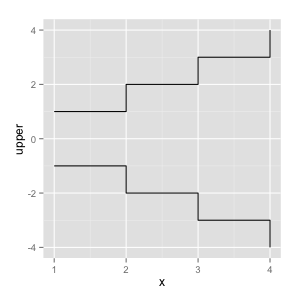R {ggplot2} で独自の geom を手軽に作りたい
重要 このエントリは {ggplot2} 1.1.0 以前の情報です。v2.0.0 以降の方法は vignettes "Extending ggplot2" を読んでください。
はじめに
{ggplot2} を使っていると、新しい描画図形 (geom) を作りたいなという場合がたまにある。その方法は {ggplot2} の Wiki に書いてあり、手順は、
- 描画図形の実体を
grid::Grobとして定義する (リンク先の例ではfieldGrob) - 定義した
Grobを 呼び出す描画用クラスをggplot2:::Geomを継承して作る (リンク先の例ではGeomField) - 描画用関数
geom_xxxを作る (リンク先の例ではgeom_field)
手順のうち 新しい Grob を作るのは少し面倒な感じだ。が、作りたい geom が 既存 {ggplot2} 関数へのちょっとした追加処理や 組み合わせで表現できる場合には新しい Grob を作る必要もなく、わりと手軽にできる。ここではその方法を書く。
やりたいこと
ggplot2::geom_ribbon を階段状に描画したい。背景はこちら。
@berobero11 そのステキ関数の存在を知りませんでした。信頼区間の塗りつぶしが一手間必要そうなので、少し時間ください。
— sinhrks (@sinhrks) 2015, 3月 241. 既存の描画用クラス (Geom) を継承して作る
ribbon を階段状に描画するには、geom_ribbon の描画直前に データを階段状に変換する必要がある。他は geom_ribbon 同様に動けばよいので、描画用のクラスは ggplot2:::Geom ではなく ggplot2:::GeomRibbon を継承してつくればよさそうだ。
補足 データを階段状に変更する処理は ggplot2 の geom-path-step.R のものを多少変更して作成。
library(ggplot2) library(proto) # 描画用クラスを定義 GeomConfint <- proto(ggplot2:::GeomRibbon, { objname <- "confint1" required_aes <- c("x", "ymin", "ymax") draw <- function(., data, scales, coordinates, na.rm = FALSE, ...) { if (na.rm) data <- data[complete.cases(data[required_aes]), ] data <- data[order(data$group, data$x), ] # ここでデータを階段状に変換 data <- .$stairstep_confint(data) ggplot2:::GeomRibbon$draw(data, scales, coordinates, na.rm = FALSE, ...) } stairstep_confint <- function (., data) { # データを階段状に変換するメソッド data <- as.data.frame(data)[order(data$x), ] n <- nrow(data) ys <- rep(1:n, each = 2)[-2 * n] xs <- c(1, rep(2:n, each = 2)) data.frame(x = data$x[xs], ymin = data$ymin[ys], ymax = data$ymax[ys], data[xs, setdiff(names(data), c("x", "ymin", "ymax"))]) } }) # 描画用クラスを呼び出す描画関数を定義 geom_confint1 <- function (mapping = NULL, data = NULL, stat = "identity", position = "identity", na.rm = FALSE, ...) { GeomConfint$new(mapping = mapping, data = data, stat = stat, position = position, na.rm = na.rm, ...) }
このとき、GeomConfint$draw の data としては、以下のように描画用に変換された data.frame が渡される。そのため、描画用データに対して処理を行う場合はこの方法が便利。
# x ymin ymax PANEL group colour fill size linetype alpha # 1 1 -1 1 1 1 NA grey20 0.5 1 0.5 # 2 2 -2 2 1 1 NA grey20 0.5 1 0.5 # 3 3 -3 3 1 1 NA grey20 0.5 1 0.5 # 4 4 -4 4 1 1 NA grey20 0.5 1 0.5
描画してみる。上で定義した描画関数 geom_confint1 がそのまま geom として使える。
df <- data.frame(x = c(1, 2, 3, 4), upper = c(1, 2, 3, 4), lower = c(-1, -2, -3, -4)) ggplot(data = df) + geom_confint1(aes(x = x, ymin = lower, ymax = upper), alpha = 0.5)

2. 描画用関数 geom_xxx だけを定義して作る
また、今回の場合 塗りつぶしが必要なければ 複数の geom_step の組み合わせでも描ける。このときは描画関数を以下のように定義すればよい。
geom_confint2 <- function (mapping = NULL, data = NULL, stat = "identity", position = "identity", na.rm = FALSE, ...) { # 上側 / 下側の階段関数 geom_step に渡す mapping を作成 mapping1 <- mapping mapping1['y'] <- mapping['ymax'] mapping2 <- mapping mapping2['y'] <- mapping['ymin'] g1 <- geom_step(mapping = mapping1, data = data, stat = stat, position = position, na.rm = na.rm, ...) g2 <- geom_step(mapping = mapping2, data = data, stat = stat, position = position, na.rm = na.rm, ...) # 複数の geom はリストで返す list(g1, g2) }
描画する。
ggplot(data = df) + geom_confint2(aes(x = x, ymin = lower, ymax = upper))

補足 ただし、上の例では mapping の変換を伴うため、以下の書式では動かない。
ggplot(data = df, mapping = aes(x = x, ymin = lower, ymax = upper)) + geom_confint2() # Error: 引数に異なる列数のデータフレームが含まれています: 7, 0
まとめ
独自の geom は正当な方法以外でもわりと手軽に作れる。
- 既存の描画用クラス (
Geom) を継承して作る - 描画用関数
geom_xxxだけを定義して作る